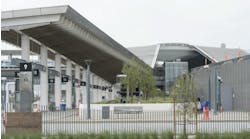Burlington, Mass.
Susan Nemetz
Executive Vice President, Fare Collection Systems, North America
Scheidt & Bachmann USA Inc.
Scheidt & Bachmann is called on to apply ex
Scheidt & Bachmann is called on to apply expertise in systems solutions and manufacturing to deliver cutting edge design, deployment and support for mass transit agencies. When considering efficient and effective internal communications to fulfill the customers’ needs, this presents myriad challenges, as we supply all aspects of the transit project including expert project management, encompassing multiple design and software development phases, manufacturing, equipment and network installation, warranty support, post-warranty support, hosting options, training, and documentation services. Through this whole process, we must be able to guide our customers through this transformation as a trusted advisor.
As the managing director for the U.S. market, I believe that my personal responsibility is to make sure that our team has the support, tools and information they need to most effectively perform their work and deliver the best possible results to our customers. In order to properly facilitate this, internal communication is critical with both our parent company as well as throughout our various facilities across the U.S. A few key practices come to light as paramount to foster proper communication:
A Solid Project Plan
The project manager should be supported by a multi-functional team representing all functions involved in delivering complex and comprehensive projects. Through this a PM is strongly supported from an organizational standpoint. Likewise the PM is empowered to render project technical and commercial decisions on behalf of the company. In the case of Scheidt & Bachmann, we utilize PRINCE 2, an internationally known and practiced Project Management Methodology (PRINCE2 is an acronym for Projects IN Controlled Environments, version 2). This was chosen as the preferred framework due to its excellent fit with the company’s project culture. It is fully organized within the organization and offers the following advantages:
- A: Our projects are conducted utilizing an internationally recognized and standardized approach
- B: Projects are in stages, enabling better control of deadlines and schedules
- C: There are standardized rules and processes to follow, allowing for transparency and an increased manageability of projects and resources
- D: Risk management used to identify and avoid, mitigate and/or solve critical events and issues
- E: Our projects are conducted in a controlled environment – accountability is ensured through determination of business case, quality criteria, and risk identification and management
- F: Pre-defined rules and standards are balanced with flexibility for optimal operation in a complex project environment
Effective Regional and Account Management
We strive to encourage growth and new opportunities within our team and while celebrating our successes. This includes adding key new roles to support our expanding customer base and changing customer needs and adding capacity in critical areas to make sure that we can deliver on our commitments. In the U.S., we’ve introduced regional and account managers who are working closely with transit management to both listen and be more responsive towards individual customer requirements. Internally, the regional managers work as a team with service and project management to ensure the implementation and continuity of principal fare collection system projects throughout the lifespan of the system. This requires the RM to wear a few hats, such as “internal marketer” and supervisor of various internal logistic and operational processes.
Good internal communications are central to the success of the company and the systems provided to our customers. For a global organization to operate seamless across locations, departments and providers, a proper plan and structure that facilitates proper communication is essential to meet critical business demands.



